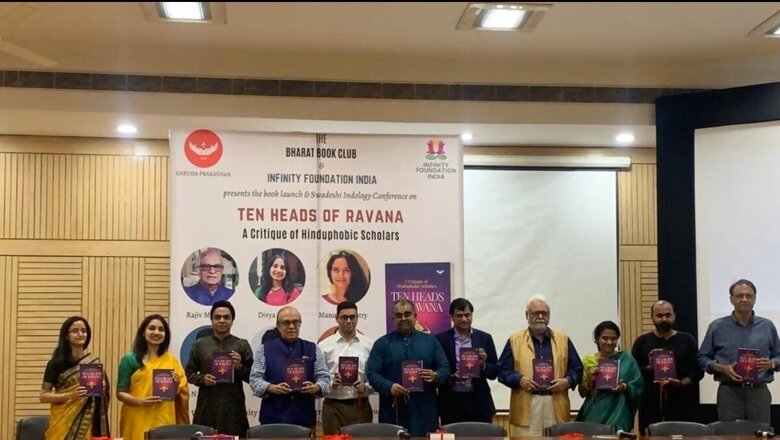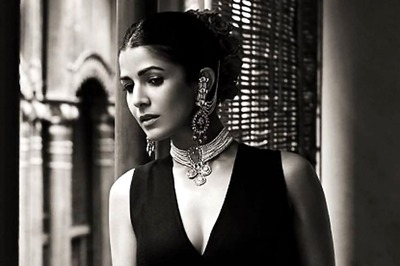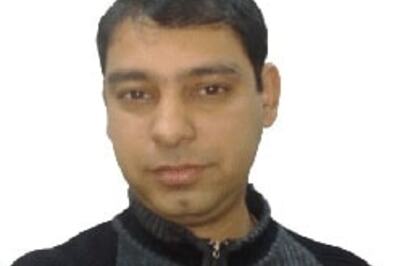
views
For the past two centuries, Indology has been controlled by Western scholars and institutions, which have applied Western methods to study Indian civilisation. Infinity Foundation has, for the past several years, been at the forefront in the field of civilisational studies, applying the lens of ‘Dharma’ to examine a broad range of topics. “The present book — Ten Heads of Ravana — is the latest offering from our team of brilliant scholars, scholars I have mentored”, says Rajiv Malhotra.
The title of this collection, Ten Heads of Ravana, has been chosen with care. The use of ‘Ravana’ is intended as a parody and not literally. The metaphorical resemblances are clear — the historical Ravana disrupted society’s Hindu structures, and the ‘heads’ chosen for this book are considered by Hindus, today, to be individuals doing something similar, but intellectually and not with physical violence.
The ten scholars featured in this book are powerful in the academic discourse today; they have worked diligently most of their lives to develop their intellectual ‘weapons’, and their impact is not to be trivialised. There is no intention on the part of the authors to attack the individuals at a personal level, but rather to cast their work in the framework from the perspective of Dharma. The authors of these essays have taken care not to engage in any ad hominem attacks or unprofessional takedowns of the individual scholars. Ramayana, one of the greatest mahakavyas of Bharat, shows us the nature of Ravana as the mighty king of Lanka and the main antagonist of the epic. He is believed to have learned the Arthashastra from Shukracharya, was adept at the use of maya, and won boons from Brahma and Shiva.
The ten contemporary scholars in this book have been chosen because their work includes aspects that many Hindus today consider adharmic, just as the historical Ravana was perceived in his time. And just as the historical Ravana defended his positions, so did the ten scholars. The authors of this book respect the opponents’ right to intellectual freedom and merely wish to offer rebuttals so the readers can decide for themselves.
Consider, for example, the article on Romila Thapar. She has been one of India’s foremost historians, having held control of premier national educational and research institutions to influence academic discourse and government policies over decades. Anurag Sharma, in his brilliant essay, refutes Thapar’s historiographical assumptions by providing strong counterexamples from Indian history.
The Sanskrit scholar Sheldon Pollock has been the subject of Rajiv Malhotra’s book, ‘The Battle for Sanskrit’. Several volumes were published from the series of Swadeshi Indology conferences held in Chennai and New Delhi by Infinity Foundation India. The editor of these volumes, Professor KS Kannan, presents a powerful essay on Pollock’s major arguments and modus operandi. Kannan shows that despite being a scholar who makes his living out of Sanskrit, Pollock denies the very nativity of Sanskrit to India and calls the language dead despite many proofs to the contrary.
Michael Witzel is an important scholar discussed in this collection of articles, and Manogna Sastry analyses his work in her cogent essay. Sastry discusses one of the major themes of Witzel’s academic work, consisting of his championing the Aryan Invasion/Migration into India theories to the point of disregarding evidence and denigrating through ad hominem attacks, the works which challenge and have negated several of his central points.
Devdutt Pattanaik is a prolific writer who has produced a vast amount of literature on various religious and social issues, especially those pertaining to India and Hinduism. Subhodeep Mukhopadhyay shows in his excellent analysis of Pattanaik’s work the protagonist’s major positions—from equating Hindutva to militant Brahmanism to praising the brilliance and simplicity of Aryan Invasion/Migration theories despite them being repeatedly discredited with evidence—which, far from being rooted in tradition, are riddled with willful misinterpretations, distortions and divisive narratives.
Irfan Habib, the Marxist scholar from Aligarh Muslim University, is the subject of Manogna Sastry’s essay. Habib has the distinction of being among the most vocal and unrelenting voices opposing the archaeological results of the excavations in Ayodhya against the backdrop of the dispute over the land demolished at the erstwhile Babri Masjid.
Shashi Tharoor, a serving Member of Parliament (Indian National Congress) of the Lok Sabha from Thiruvananthapuram, Kerala, and the former Under-Secretary General of the United Nations forms the subject of Divya Reddy’s article. In popular media and for most aspirational urban Indians, Tharoor is seen as a slick and eloquent interpreter of Hinduism for the 21st century. Reddy shows that Tharoor’s work on Hinduism consists of an assortment of theories drawn from colonial Indologists and historians. These historians have been rejected because they used the colonised lens to conjure a history of India.
In their analysis of Audrey Truschke’s work, Subhodeep Mukhopadhyay and Manogna Sastry explicate the key themes of her research. Truschke’s positions on Hinduism and Hindutva, her whitewashing of the temple destructions that took place under Aurangzeb’s rule, her blatant misrepresentations of incidents from the Ramayaṇa through mistranslations and other important aspects are studied through a careful analysis of her writings.
Ramachandra Guha’s work forms the subject of Sudarshan TN and Divya Reddy’s study in the current volume. Guha, known for his elaborations on “Nehru, MK Gandhi, cricket history, environment, politics, and economics,” was the recipient of the Padma Bhushan in 2009, India’s third-highest civilian award. The threads of subalternism, colonialism, nationalism, Marxism, and the blatant hatred for Hindutva seen in Guha’s work are unpacked by the authors for the general reader.
Kancha Ilaiah Shepherd’s work is analysed by Sharda Narayanan and Subhodeep Mukhopadhyay. Ilaiah, who has been hoisted as one of India’s foremost social thinkers, is instrumental in internationalizing Dalit issues and bringing them to the attention of global institutions. Narayanan and Mukhopadhyay analyse critically the major themes of Ilaliah’s work and expose his research methodology and calibre, including his use of superficial similarities in name endings to establish a fantastic linkage between the Harappan civilization and the Bible!
The American Indologist Wendy Doniger, whose academic activity has spanned over 40 years with several tomes in different genres, including interpretive works on religion, translations, and edited volumes, forms the subject of Dr. Meera Kannan’s essay. The author, through a meta-analysis of Doniger’s methods and frameworks of study, shows how Doniger’s understanding of Indian chronology leads to several wrong interpretations of the historical timelines of important texts of the Sanskrit canon.
The writer of the article hopes this collection of essays in the book accomplishes two aims: the first is to introduce the general reader to some of the intellectual giants whose role hasn’t been constructive. The second aim is especially important in helping one understand and build a pūrvapakṣa (view) of some of the most important narratives of India.
Yuvraj Pokharna is an independent journalist and columnist. He tweets with @pokharnaprince. Views expressed are personal.
Read all the Latest Opinions here


















Comments
0 comment